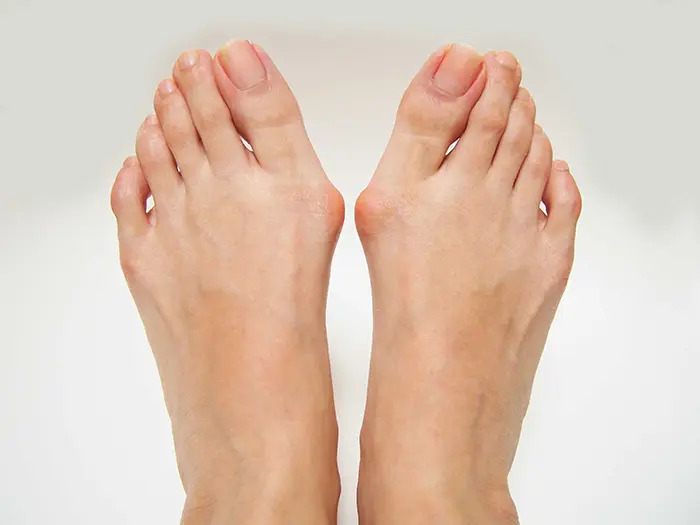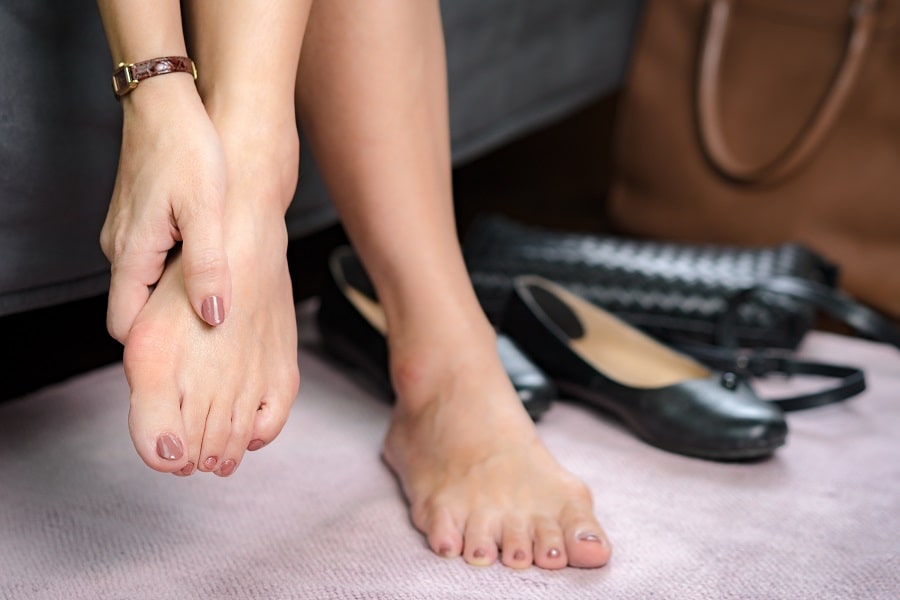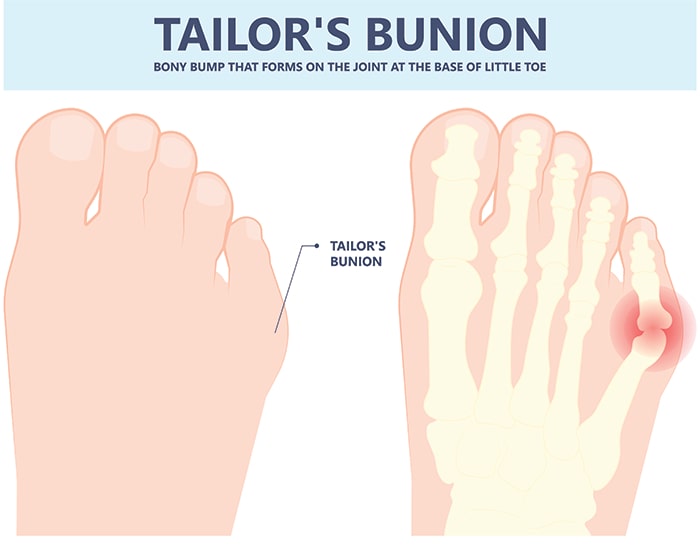Phone: +44 (0)20 8492 1600
Need help or have a question?
Contact us at: [email protected]
You may have heard the word “bunion” used on television or in conversation, but do you know what it is?
A bunion, or hallux valgus, looks just like a bulge at the base of your big toe. Though it looks like your foot is growing a bony bump, it is in fact caused by a shift in your bones which starts to push out towards the skin.
The bump itself is caused by a deformity in the joint between your big toe and foot bones (the first metatarsophalangeal or MTP joint). The first metatarsal bone (bone that connects your foot to your big toe) starts to angle outward, and your phalanges (bones that make up your toe) move inwards. When this happens, the joint begins to form an angle.
Think of it like a bendy straw. When you get it out of the packet the straw is straight but has a hinge that acts like a joint to allow you to move the top end. The MTP joint acts like this hinge to help movement of the toe, but when a bunion forms the toe gets stuck in the bent position.

A Bunion might be obvious when you look at a picture, but often the process can develop slowly over many years. If you only have a mild bunion you may not have noticed the change .
There are several symptoms that bunions can cause, including:
Because the bunion can take years to form, it generally affects older people, or those whose family members have also suffered from bunions.
Other common foot conditions can cause similar symptoms, such as gout, arthritis, and cysts. If you have any doubts about whether you have a bunion you should see a podiatrist or your GP.
Classic Bunion – Hallux Valgus
The most common type of bunion occurs in adults and looks like a bump or swelling at the base of your great toe. In addition, your toe starts to bend towards your other toes and can cause your toes to look crowded.
Adolescent bunion
Adolescent bunions look similar to the classic bunion but occurs in teenagers and adolescents. The cause is often due to an inherited family trait, or by conditions which are risk factors for bunions such as cerebral palsy or down’s syndrome.
Bunionette – Tailors’ bunion
A bunionette occurs in a similar way to the classic bunion, but instead affects the joint connecting your little toe to your foot. The result is a bump on the opposite side of a classic bunion – at the base of your little toe.
Congenital hallux valgus
A congenital bunion is present at birth, so is often seen in young children. The big toe looks like it’s turned inwards. This is a rare condition.

Bunions form because of pressure on your MTP joint, which can be caused by the way you walk and how your foot is shaped. Those that suffer from bunions have often inherited a faulty foot structure that makes it more likely that a bunion will form.
It is sometimes said that tight fitting shoes and high heels can cause bunions, but this is not the case. Crowding your toes and applying added pressure may worsen the deformity but doesn’t cause it in the first place. You might also find that tight shoes cause more pain and inflammation at the site of your bunion.
Risk factors for developing a bunion include:
Because there are other conditions that can mimic a bunion, it’s important that you see your GP to get your feet examined. X-rays confirm a diagnosis of hallux valgus and give you an idea of how severe your bunion is.
While you might want to treat your bunion just to ease the associated pain and swelling, it’s important to prevent any complications that can arise from bunions. If your bunion gets worse or develops a complication, you may end up requiring surgery, so it’s vital to get the right treatment. Possible complications of bunions include:
Once you have a bunion it is impossible to get rid of it – but if you are at risk of bunions or have a mild one, you can take some steps to stop it from getting worse. If you notice a bunion forming it’s a good idea to visit a pharmacist or foot care professional, who can help you to protect your feet from further harm. Your GP or podiatrist may recommend:
When buying new shoes, you should try to shop in the evening. As the day progresses your feet swell. Shoes that seemed like they fit earlier might get tighter as the day goes on! If you suffer from bunions, it’s best to go to a shop to try shoes on rather than ordering online. Suitable shoes will be a little loose, support your arch, and be wide enough that your toes don’t feel crowded.

What is a Bunion?
Whether your bunions are just causing a mild bother or are so bad that you dread putting on your shoes, it’s important that you get treatment and prevent any further damage. As well as the tips mentioned above, there are several treatment options. Some measures you can take yourself include:
If you want to get a little extra help for your bunion, it might be a good idea to consult your GP or podiatrist. They can offer a range of therapies to ease your pain and prevent the bunion from getting worse including:
For severe bunions, those who have developed complications, or people who have tried everything but are still getting pain and discomfort, surgery is a possibility. This is a big decision as complete recovery from a bunion surgery can take months, and you won’t be able to put weight on that foot for weeks.
The aim of surgery is to correct the deformity or treat the complication. There are a great many techniques your surgeon might recommend depending on the severity, structure, and cause of your bunion.
The Profoot Bunion Guard can provide instant relief from painful bunions. It has 2-in-1 action of being a bunion corrector and supplying padding. It works to both treat and prevent complications by:
Profoot Bunion Pads help to cushion your bunion with a double layer of super soft moleskin. This reduces the rubbing and pressure in order to ease your pain and make it more comfortable to wear shoes.
“I was pleasantly surprised despite how thick they looked however they fit perfectly against hiking boots and shoes. Very comfortable and have made the world of difference. Soft fabric. Will definitely buy more. Adhesion is pretty good but placement is key so will consider next time use. Started to peel at the end of day but I had been walking half of the day!” Ms Marie Holloway, Amazon review of Profoot Bunion Pads.
“I would recommend this very comfortable and slim to fit in shoes. Good for stopping friction on the bunion would buy again” Mrs. S. M. Edney, Amazon review of Profoot Bunion Pads.
The Profoot Soft Gel Bunion Protector has advanced polymer gel technology to provide pain relief for your bunions. It conforms to the shape of your foot and can last for weeks. The cushioned material is kind on your skin and helps to soften and prevent corns and calluses.
“I have tried several bunion products and found the sleeve variety, moved around and didn’t stay in place. I was sceptical about the Profoot Bunion Protector but these have worked for me. Ideal for wearing when jogging or wearing trainers.” Lis, Amazon review of Profoot Bunion Protector.
“I can’t believe a simple device like this gives such relief! I’m so pleased and am about to order some more. Walking is much more comfortable.” Mpk, Amazon review of Profoot Bunion Protector.
The Profoot Gel Bunion Sleeve is a super-soft reusable sleeve that helps to reduce pressure and rubbing on your bunion.
“Best thing I brought. Pain-free” customer review on tesco.com
“Seemed expensive when I purchased it about 12 months ago. However I have used it at least 3 times a week when golfing (including washing it regularly) and it is still in good condition so it looks like it will be ok for another 6 months. As such it represents fair value for money and I have already purchased another one” Amazon customer.
The Profoot Soft Gel Toe Spreader works as a bunion corrector by properly aligning your toes. This can help prevent issues such as hammertoe and supplies soft relief for your toe pain.
“My husband has a very bad bunion making his big toe cross over and press on the adjoining toe which is also a hammer toe. This causes him a lot of pain especially when walking. The silicone Profoot Toe Spreader is ideal as it keeps the big toe apart from the adjoining toe and prevents them pressing on each other which lessens the pain and enables my husband to walk better.
Would recommend any of the Profoot Products having used them a lot over the years but the Toe Spreader is a real gem and a tremendous help.” Louisa, Amazon review of Profoot Toe Spreader.
“Having a troublesome big toe joint, I noticed it was beginning to ‘go over’ so I decided to buy one of these, on the advice of a friend, who also uses these regularly. It is effective and also a good price. I can also wear it when I am walking a few miles, without it coming adrift. Pleased with it!” Anjiejag, Amazon review of Profoot Toe Spreader.
The Profoot Super Sport Arch/Heel Support protects your feet from the consequences of a bunion. As you start to feel pain and rubbing from the bunion, you’ll automatically start to shift your weight to other parts of your foot. Mistake! This can lead to arthritis, foot pain, and Metatarsalgia.
With these insoles you can reduce knee and foot pains, while protecting your arches and making walking feel like a dream.
“It took a couple of days to get used to them but they really have eased the pain in my heels! If I wear a pair of shoes and have forgot to put them in I can’t walk very far without the pain becoming unbearable! These supports have given me my life back!” vw1, Amazon review.
This article was written by Dr. James Philip MBChB who graduated from the University of Manchester in 2015 and went on to train in hospitals across the North West of England. He has experience working in both hospital medicine, and the community, and played his part as a front line worker on the COVID-19 wards. He now works as a freelance medical writer and medical education entrepreneur.